Jellyfish Search Optimization Algorithm for MPP Tracking of PV System
Abstract
:1. Introduction
2. PV Framework Formulation
Characteristic Curves of a Solar Cell
3. Maximum Power Point Tracking (MPPT)
Partial Shading Conditions (PSC)
4. Jellyfish Search Optimization Method
- The jellyfish’s own movement within the swarm.
- Pursuing the ocean current to develop jellyfish bloom.
- The motions of jellyfish in the ocean are illustrated in Figure 8. The JSO algorithm considers the succeeding idealized principles:
- The time control procedure administers switching between the two advanced movements of the jellyfish (i.e., the movements inside the swarm and following the ocean flow).
- Jellyfish are more drawn to areas where the accessible amount of food is more significant.
- The measure of food found is controlled by the location and its related target function.
4.1. Ocean Current
4.2. Jellyfish Swarm
4.3. Time Control Component
5. Performance of Jellyfish Search Optimization Algorithm for MPPT
6. Performance Comparison
7. Conclusions
- i.
- By undergoing hybridization with the other algorithms, such a modification can outweigh the drawbacks of the strategies employed to form new features and result in improving the output yield of the PV systems.
- ii.
- Real-time assessment of the algorithms can be performed in order to obtain the practical validation of the MPPT algorithms, which ignites the need of further study.
- iii.
- The most common hot-spot problem can be taken into account to update this work.
Author Contributions
Funding
Acknowledgments
Conflicts of Interest
References
- André, T.; Ute Collier, A.B.; Dent, C.; Epp, B.; Gibb, D.; Kumar, C.H.; Joubert, F.; Kamara, R.; Ledanois, N.; Mastny, L.; et al. Renewables 2021 Global Status Report; Mastny, L., Brumer, L., Eds.; REN21 Secretariat: Paris, France, 2021; ISBN 978-3-948393-03-8. [Google Scholar]
- Saravanan, S.; Babu, N.R. Maximum power point tracking algorithms for photovoltaic system—A review. Elsevier Renew. Sustain. Energy Rev. 2016, 57, 192–204. [Google Scholar] [CrossRef]
- Hameed, W.I.; Saleh, A.L.; Sawadi, B.A.; Al-Yasir, Y.I.A.; Abd-Alhameed, R.A. Maximum Power Point Tracking for Photovoltaic System by Using Fuzzy Neural Network. Inventions 2019, 4, 33. [Google Scholar] [CrossRef] [Green Version]
- El Hammoumi, A.; Motahhir, S.; El Ghzizal, A.; Chalh, A.; Derouich, A. A simple and low-cost active dual-axis solar tracker. Energy Sci. Eng. 2018, 6, 607–620. [Google Scholar] [CrossRef] [Green Version]
- Chalh, A.; Motahhir, S.; El Hammoumi, A.; El Ghzizal, A.; Derouich, A. Study of a Low-Cost PV Emulator for Testing MPPT Algorithm Under Fast Irradiation and Temperature Change. Technol. Econ. Smart Grids Sustain. Energy 2018, 3, 11. [Google Scholar] [CrossRef] [Green Version]
- Verma, D.; Nema, S.; Shandilya, A.M.; Dash, S.K. Maximum power point tracking (MPPT) techniques: Recapitulation in solar photovoltaic systems. Renew. Sustain. Energy Rev. 2016, 54, 1018–1034. [Google Scholar] [CrossRef]
- Abdul-Kalaam, R.; Muyeen, S.; Al-Durra, A. Review of maximum power point tracking techniques for photovoltaic system. Global J. Control Eng. Technol. 2016, 2, 8–18. [Google Scholar]
- Karami, N.; Moubayed, N.; Outbib, R. General review and classification of different MPPT Techniques. Renew. Sustain. Energy Rev. 2017, 68, 1–18. [Google Scholar] [CrossRef]
- Masoum, M.; Dehbonei, H.; Fuchs, E. Theoretical and experimental analyses of photovoltaic systems with voltageand current-based maximum power-point tracking. IEEE Trans. Energy Convers. 2002, 17, 514–522. [Google Scholar] [CrossRef] [Green Version]
- Piegari, L.; Rizzo, R. Adaptive perturb and observe algorithm for photovoltaic maximum power point tracking. IET Renew. Power Gener. 2010, 4, 317–328. [Google Scholar] [CrossRef]
- Kamran, M.; Mudassar, M.; Fazal, M.R.; Asghar, M.U.; Bilal, M.; Asghar, R. Implementation of improved Perturb & Observe MPPT technique with confined search space for standalone photovoltaic system. J. King Saud Univ.—Eng. Sci. 2018, 32, 432–441. [Google Scholar] [CrossRef]
- Hua, C.-C.; Chen, Y.-M. Modified perturb and observe MPPT with zero oscillation in steady-state for PV systems under partial shaded conditions. In Proceedings of the 2017 IEEE Conference on Energy Conversion (CENCON), Kuala Lumpur, Malaysia, 30–31 October 2017; pp. 5–9. [Google Scholar] [CrossRef]
- Yamashita, H.; Tamahashi, K.; Michihira, M.; Tsuyoshi, A.; Amako, K.; Park, M. A novel simulation technique of the PV generation system using real weather conditions. In Proceedings of the Power Conversion Conference—Osaka 2002 (Cat.No.02TH8579), Osaka, Japan, 2–5 April 2002; Volume 2, pp. 839–844. [Google Scholar]
- Kumar, M.V.; Mogili, A.R.; Anusha, S.; Kumar, N.A. A New Fuzzy based INC-MPPT Algorithm for Constant Power Generation in PV Systems. Intern. Res. J. Eng. Tech. 2021, 8, 212–217. [Google Scholar]
- Calvinho, G.; Pombo, J.; Mariano, S.; Calado, M.D.R. Design and Implementation of MPPT System Based on PSO Algorithm. In Proceedings of the IEEE International Conference on Intelligent Systems (IS), Funchal, Portugal, 25–27 September 2018; pp. 732–738. [Google Scholar]
- Khazain, M.A.; Hidayat, N.M.; Burhanudin, K.; Abdullah, E. Boost Converter of Maximum Power Point Tracking (MPPT) Using Particle Swarm Optimization (PSO) Method. In Proceedings of the 2021 IEEE 12th Control and System Graduate Research Colloquium (ICSGRC), Shah Alam, Malaysia, 7 August 2021. [Google Scholar]
- Narendiran, S.; Sahoo, S.K.; Das, R.; Sahoo, A.K. Fuzzy logic controller based maximum power point tracking for PV system. In Proceedings of the 2016 3rd IEEE International Conference on Electrical Energy Systems (ICEES), Chennai, India, 17–19 March 2016; pp. 29–34. [Google Scholar]
- Basha, C.H.; Rani, C. Different Conventional and Soft Computing MPPT Techniques for Solar PV Systems with High Step-Up Boost Converters: A Comprehensive Analysis. Energies 2020, 13, 371. [Google Scholar] [CrossRef] [Green Version]
- Lopez-Santos, O.; Garcia, G.; Martinez-Salamero, L.; Giral, R.; Vidal-Idiarte, E.; Merchan-Riveros, M.C.; Moreno-Guzman, Y. Analysis, Design, and Implementation of a Static Conductance-Based MPPT Method. IEEE Trans. Power Electron. 2018, 34, 1960–1979. [Google Scholar] [CrossRef]
- Dhawan, S.; Gupta, R.; Rana, A.; Sharma, S. Various Swarm Optimization Algorithms: Review, Challenges, and Opportunities. In Soft Computing for Intelligent Systems; Marriwala, N., Tripathi, C.C., Jain, S., Mathapathi, S., Eds.; Springer: Singapore, 2021; pp. 291–301. ISBN 978-981-16-1048-6. [Google Scholar]
- Bonabeau, E.; Dorigo, M.; Theraulaz, G. Swarm Intelligence: From Natural to Artificial Systems; Oxford University Press: New York, NY, USA, 1999; Chapter 5; ISBN 9780195131581. [Google Scholar]
- Ab Wahab, M.N.; Nefti-Meziani, S.; Atyabi, A. A Comprehensive Review of Swarm Optimization Algorithms. PLoS ONE 2015, 10, e0122827. [Google Scholar] [CrossRef] [PubMed] [Green Version]
- el Hariza, Z.; Aissaouia, H.; Dianya, M. A Novel PID Using A Genetic Algorithm to Track the Maximum Power Point of the PV System. In Advanced Research in Solar Energy; Kale, S.A., Ed.; Grinrey: Pune, India, 2021; Volume 1, pp. 81–98. ISBN 978-81-948951-7-6. [Google Scholar]
- Sundareswaran, K.; Kinattingal, G.S.; Simon, S.; Nayak, P. MPPT in PV systems using ant colony optimisation with dwindling population. IET Renew. Power Gener. 2020, 14, 1105–1112. [Google Scholar] [CrossRef]
- Slowik, A.; Kwasnicka, H. Evolutionary algorithms and their applications to engineering problems. Neural Comput. Appl. 2020, 32, 12363–12379. [Google Scholar] [CrossRef] [Green Version]
- Gonzalez-Castano, C.; Restrepo, C.; Kouro, S.; Rodriguez, J. MPPT Algorithm Based on Artificial Bee Colony for PV System. IEEE Access 2021, 9, 43121–43133. [Google Scholar] [CrossRef]
- Jamaludin, M.N.I.; Tajuddin, M.F.N.; Ahmed, J.; Azmi, A.; Azmi, S.A.; Ghazali, N.H.; Babu, T.S.; Alhelou, H.H. An Effective Salp Swarm Based MPPT for Photovoltaic Systems Under Dynamic and Partial Shading Conditions. IEEE Access 2021, 9, 34570–34589. [Google Scholar] [CrossRef]
- Chou, J.-S.; Truong, D.-N. A novel metaheuristic optimizer inspired by behavior of jellyfish in ocean. J. Elsevier Appl. Math. Comput. 2020, 389, 125535. [Google Scholar] [CrossRef]
- Ilyas, A.; Ayyub, M.; Khan, M.R.; Husain, M.A.; Jain, A. Hardware Implementation of Perturb and Observe Maximum Power Point Tracking Algorithm for Solar Photovoltaic System. Trans. Electr. Electron. Mater. 2018, 19, 222–229. [Google Scholar] [CrossRef]
- Saadsaoud, M.; Abbasi, H.A.; Kermiche, S.; Ouada, M. Study of Partial Shading Effects on Photovoltaic Arrays with comprehensive Simulator for Global MPPT control. Inter. J. Renew. Energy Res. 2016, 6, 413–420. [Google Scholar]
- Salem, F.; Awadallah, M.A. Detection and assessment of partial shading in photovoltaic arrays. J. Electr. Syst. Inf. Technol. 2016, 3, 23–32. [Google Scholar] [CrossRef] [Green Version]
- Fossette, S.; Putman, N.F.; Lohmann, K.J.; Marsh, R.; Hays, G.; Hays, G. A biologist’s guide to assessing ocean currents: A review. Mar. Ecol. Prog. Ser. 2012, 457, 285–301. [Google Scholar] [CrossRef] [Green Version]
- Abdel-Basset, M.; Mohamed, R.; Chakrabortty, R.K.; Ryan, M.J.; El-Fergany, A. An Improved Artificial Jellyfish Search Optimizer for Parameter Identification of Photovoltaic Models. Energies 2021, 14, 1867. [Google Scholar] [CrossRef]





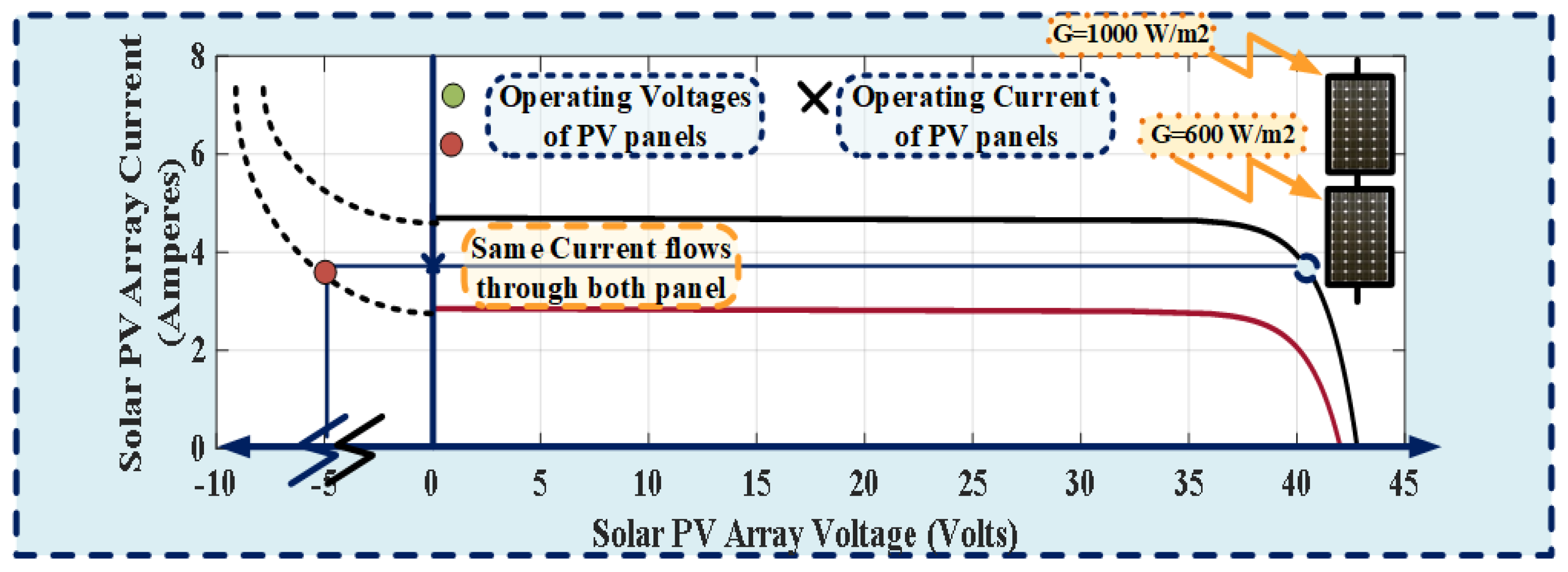

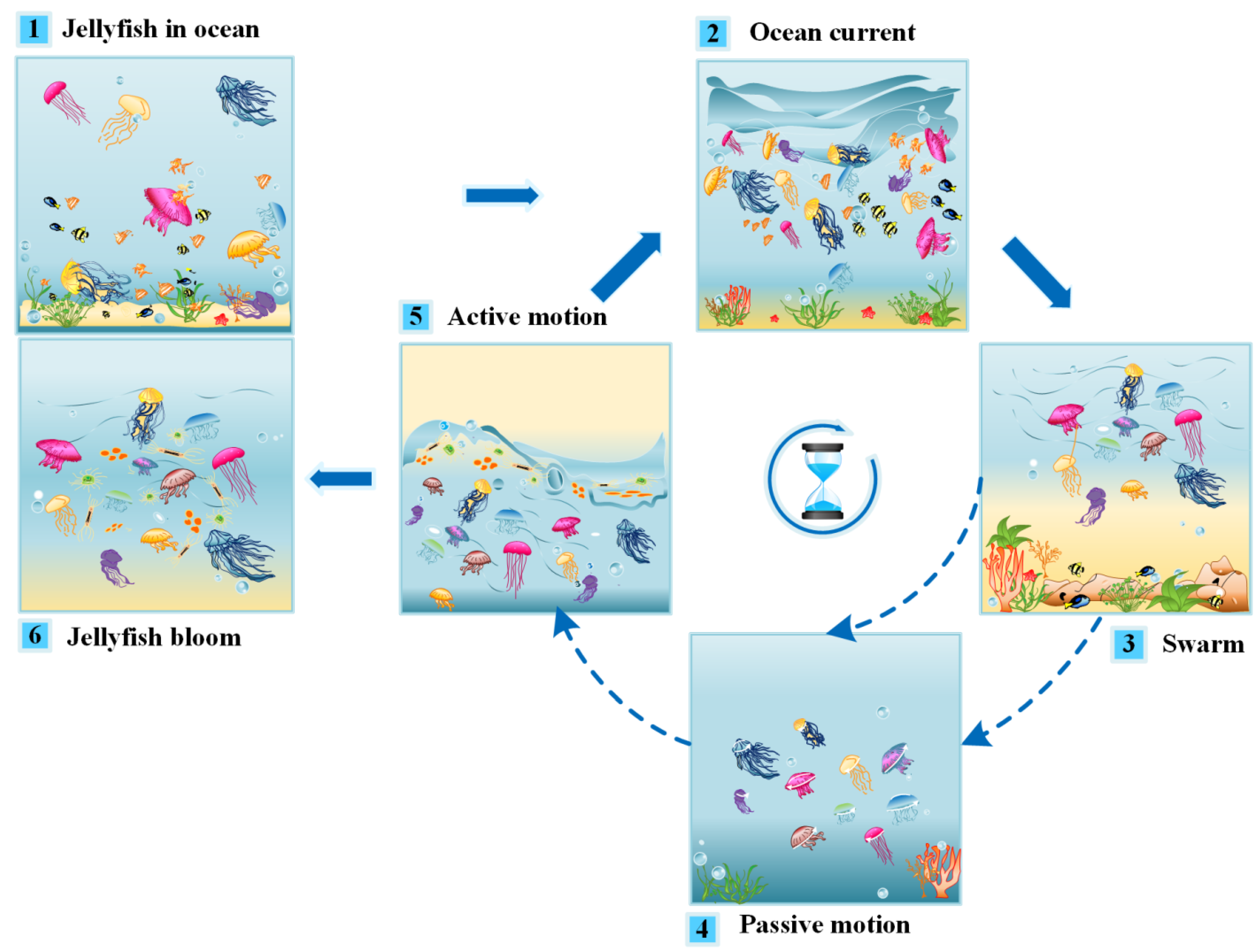

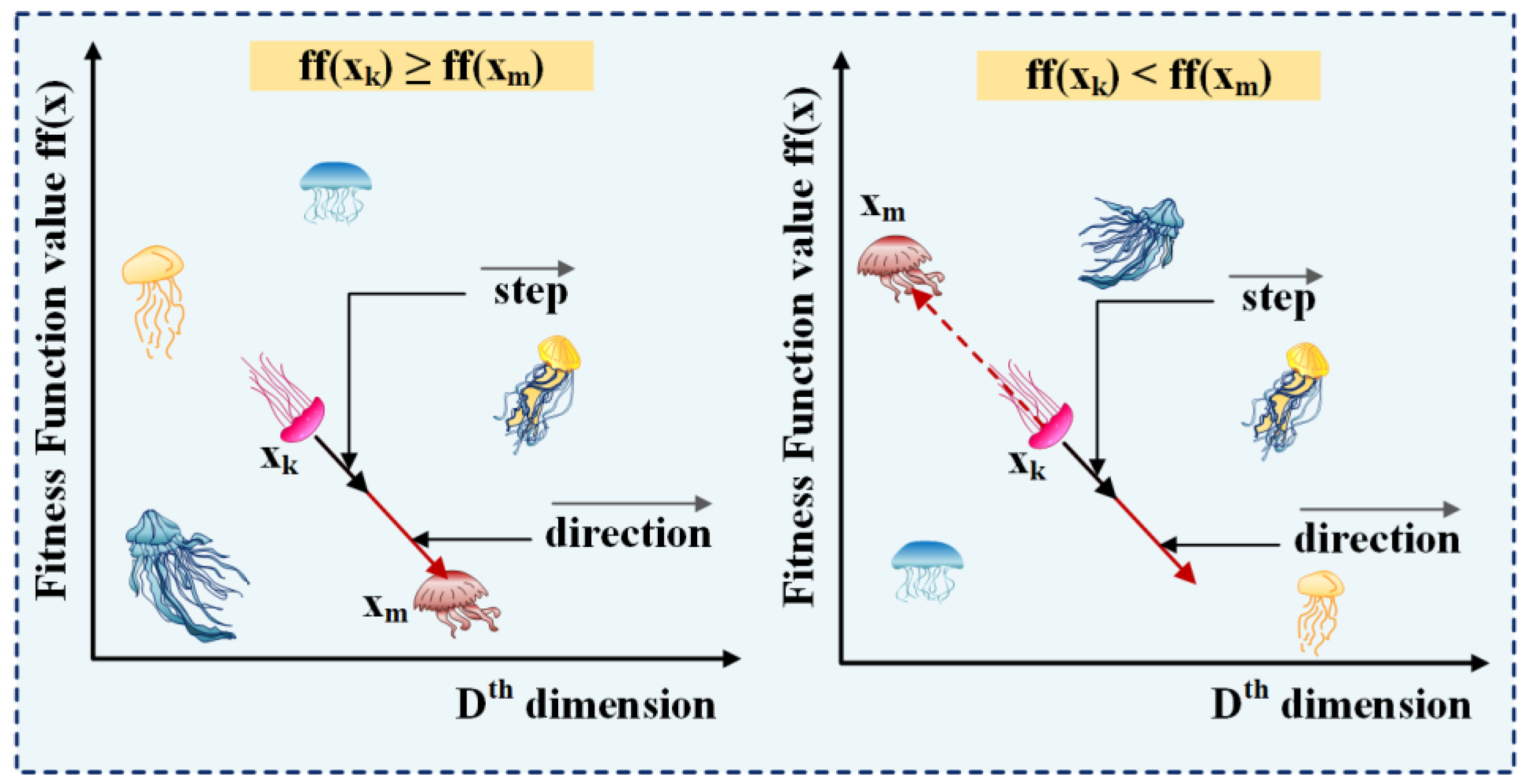

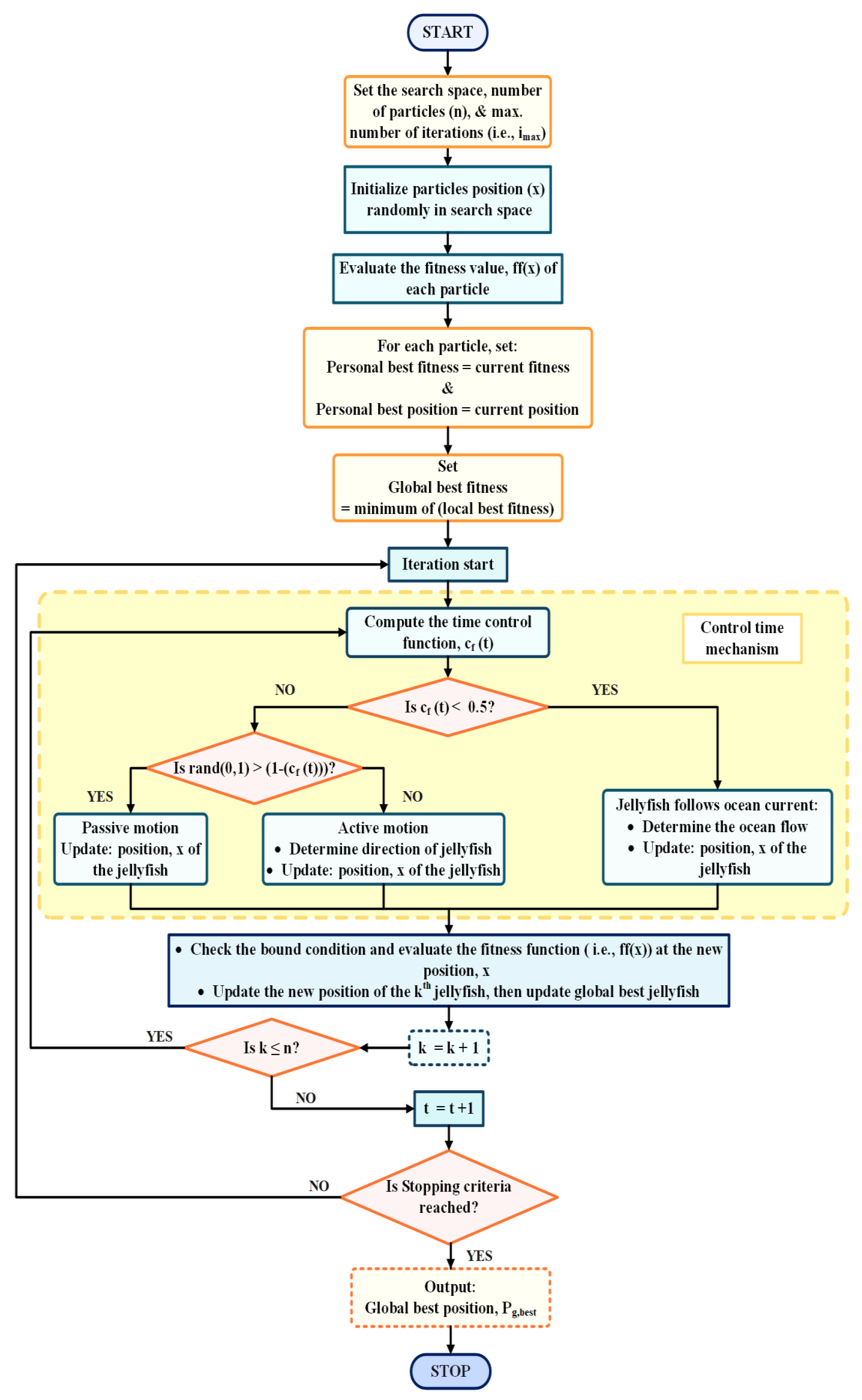
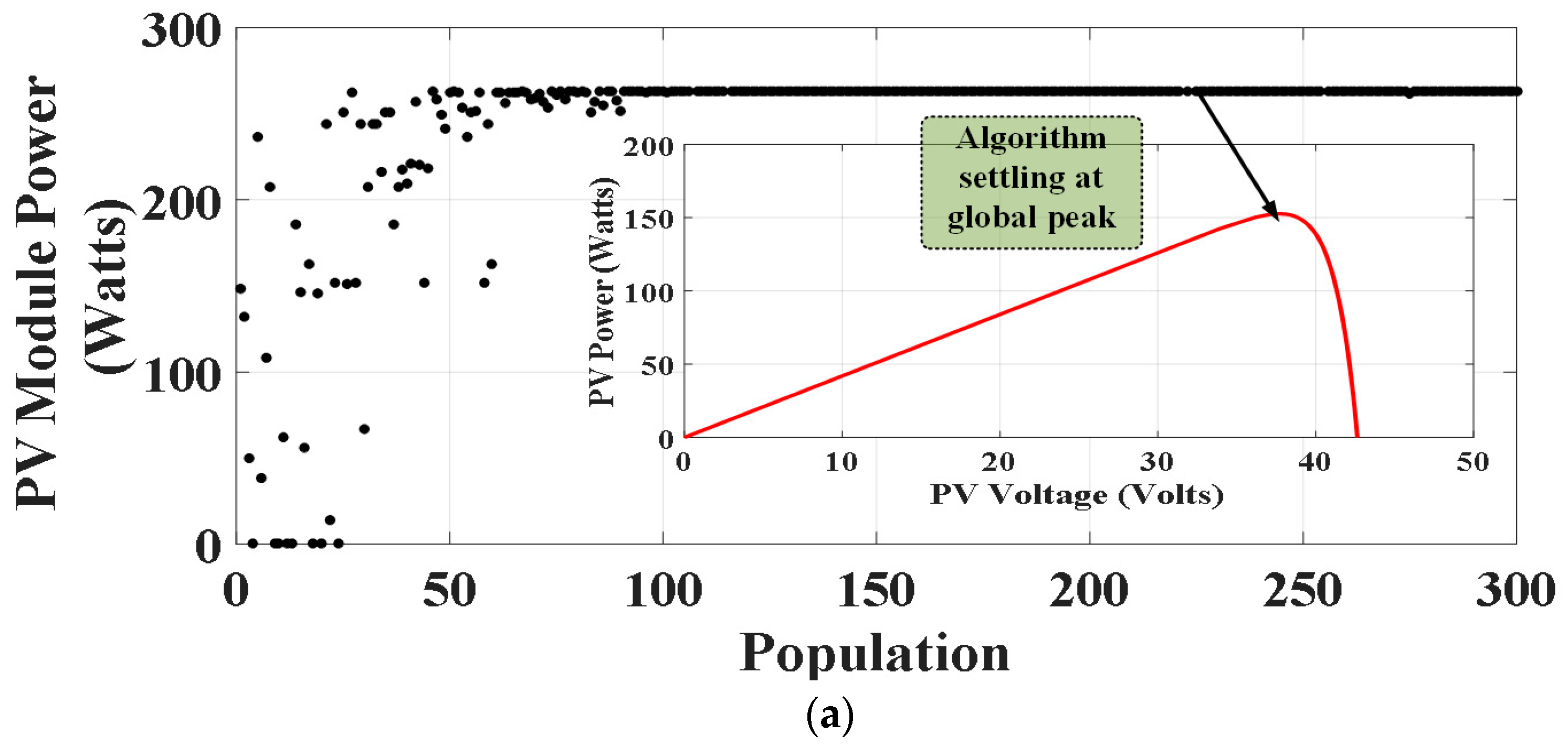

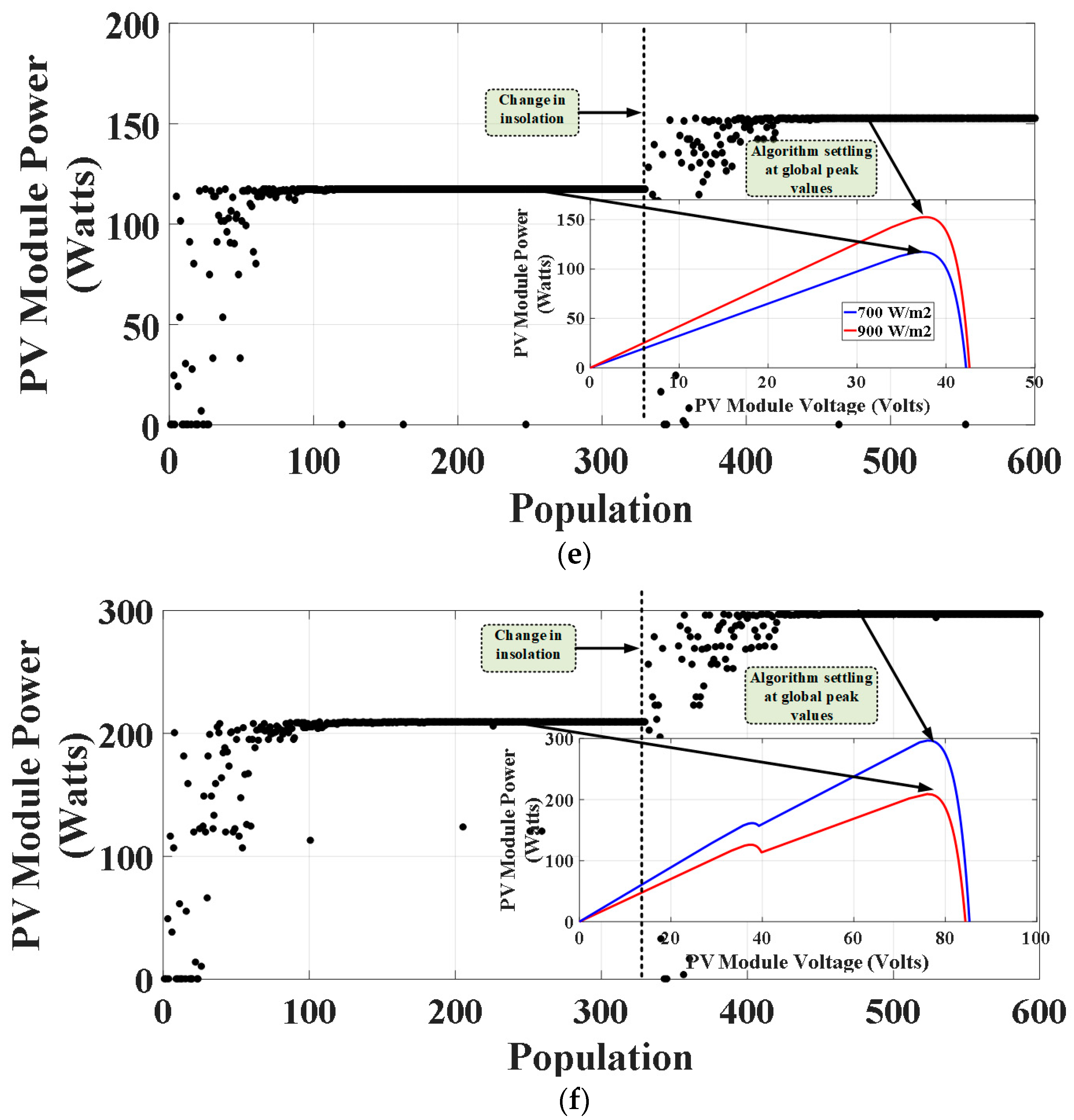


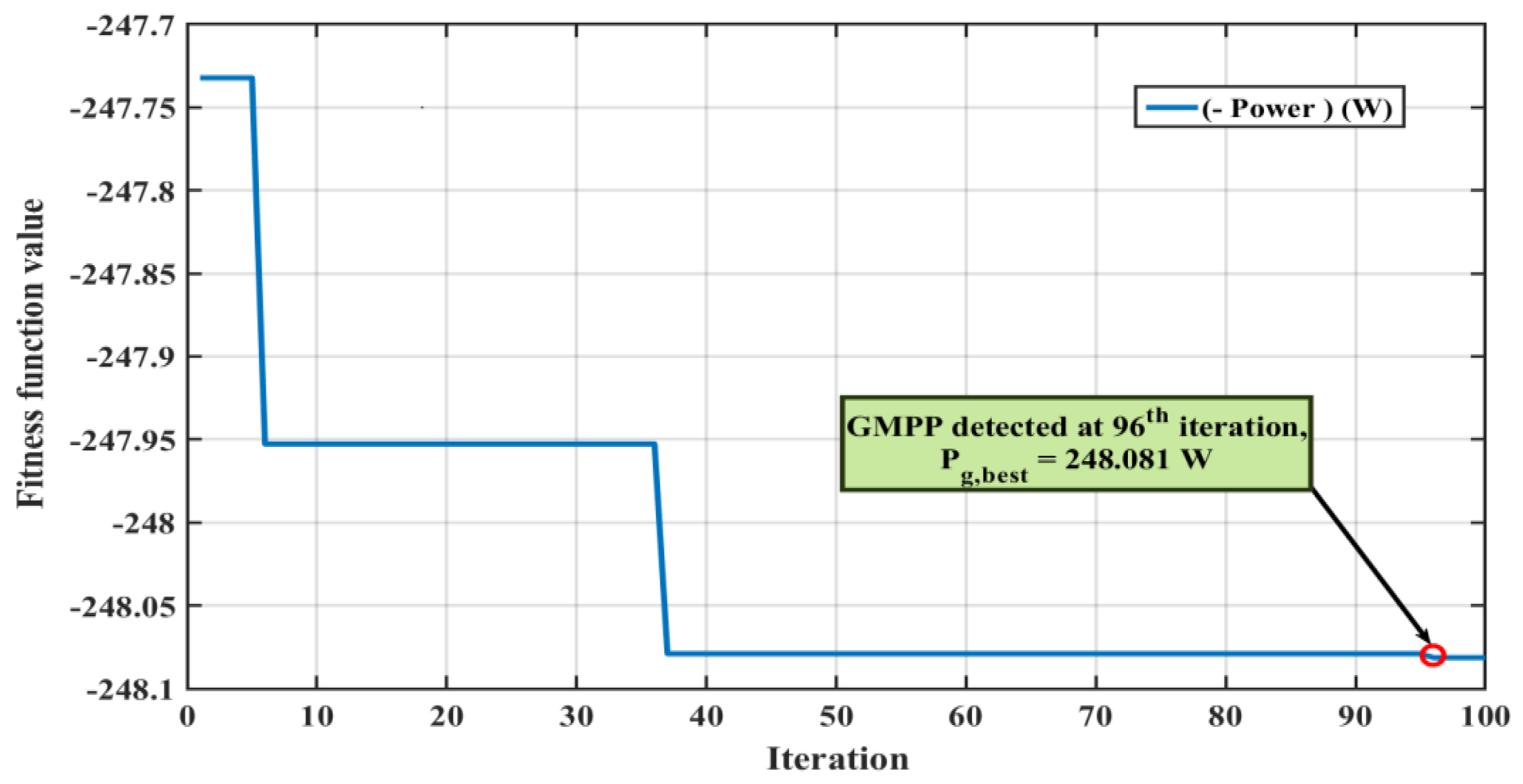

| Specification | Value |
|---|---|
| Open-circuit voltage; Voc | 42.8 V |
| Short-circuit current; Isc | 4.7 A |
| Temperature coefficient of Voc | −0.152 (V/°C) |
| Temperature coefficient of Ioc | 0.002 (A/°C) |
| Each string PV cells in series; Ns | 48 |
| Parameters | Jellyfish Search Optimization (JSO) | Particle Swarm Optimization (PSO) |
|---|---|---|
| PGMPP = | Best function value | (W) | 511.1226 | 511.1226 |
| Best run | 3 | 1 |
| Best variable | 4.5009 | 4.5013 |
| Time elapsed (s) | 35,465.5306 | 85,135.1638 |
| Parameters | Jellyfish Search Optimization (JSO) | Particle Swarm Optimization (PSO) |
|---|---|---|
| PGMPP = | Best function value | (W) | 248.081 | 248.081 |
| Best run | 4 | 1 |
| Best variable | 3.2071 | 3.2072 |
| Time elapsed (s) | 4269.5465 | 71,644.560175 |
Publisher’s Note: MDPI stays neutral with regard to jurisdictional claims in published maps and institutional affiliations. |
© 2021 by the authors. Licensee MDPI, Basel, Switzerland. This article is an open access article distributed under the terms and conditions of the Creative Commons Attribution (CC BY) license (https://creativecommons.org/licenses/by/4.0/).
Share and Cite
Alam, A.; Verma, P.; Tariq, M.; Sarwar, A.; Alamri, B.; Zahra, N.; Urooj, S. Jellyfish Search Optimization Algorithm for MPP Tracking of PV System. Sustainability 2021, 13, 11736. https://doi.org/10.3390/su132111736
Alam A, Verma P, Tariq M, Sarwar A, Alamri B, Zahra N, Urooj S. Jellyfish Search Optimization Algorithm for MPP Tracking of PV System. Sustainability. 2021; 13(21):11736. https://doi.org/10.3390/su132111736
Chicago/Turabian StyleAlam, Afroz, Preeti Verma, Mohd Tariq, Adil Sarwar, Basem Alamri, Noore Zahra, and Shabana Urooj. 2021. "Jellyfish Search Optimization Algorithm for MPP Tracking of PV System" Sustainability 13, no. 21: 11736. https://doi.org/10.3390/su132111736
APA StyleAlam, A., Verma, P., Tariq, M., Sarwar, A., Alamri, B., Zahra, N., & Urooj, S. (2021). Jellyfish Search Optimization Algorithm for MPP Tracking of PV System. Sustainability, 13(21), 11736. https://doi.org/10.3390/su132111736










